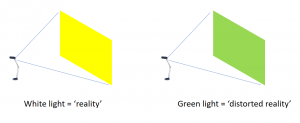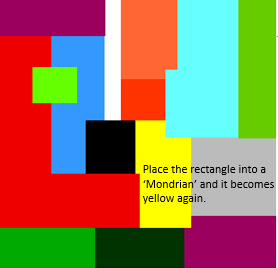
At the risk of an accusation of pedantry, an accusation regularly thrown my way, I can confidently state that regardless of which eye he used, Nelson definitely saw no ships at the battle of Copenhagen. What he may have seen is the light reflected from the surface of the ships.
Our perception of the world around us is reliant upon the light that is shone upon it.
It is many years since scientists first discovered that solid objects have no colour themselves, they simply reflect different colours of light from the spectrum that is shone upon them. What we see is a reflected light rather than the object itself.
A scientist called Edwin Land conducted a series of experiments in the 1970s that became known as the Land Mondrian experiments. He concluded that not only do objects have no colour, colour is not a property of light either, but a sensation that arises in the brain. There is no need to go into that too deeply here, however here is a brief summary of what he did and found.
An object we regard with 100% certainty can appear completely different when presented as part of a group of objects.
He would show participants in a featureless room, a coloured rectangle of paper in normal, ‘white light’, let’s use yellow in this example. They would all report it as a yellow rectangle. He would then manipulate the light source to project only green light. All participants would report the rectangle’s colour as green.  He then introduced more coloured rectangles in an image reminiscent of a Mondrian painting. He found in this case that when the source of the light was manipulated to project only green light, participants still reported the original colour as reflected in white light, indeed they reported all colours in the Mondrian image as though reflected in white light. So by referencing the relative intensity of light from each rectangle they were able to achieve colour constancy, regardless of the colour of light in the room. All very interesting, but why am I talking about human perception of light? Well, although I have simplified the experiment slightly, its relevance to the workplace is twofold. First, it nicely illustrates the interpolative nature of our brains; even when the information coming at us is incomplete or distorted, we can still form an accurate picture. Secondly, it provides a nice metaphor for a behavioural scientist to make a point about leadership.
He then introduced more coloured rectangles in an image reminiscent of a Mondrian painting. He found in this case that when the source of the light was manipulated to project only green light, participants still reported the original colour as reflected in white light, indeed they reported all colours in the Mondrian image as though reflected in white light. So by referencing the relative intensity of light from each rectangle they were able to achieve colour constancy, regardless of the colour of light in the room. All very interesting, but why am I talking about human perception of light? Well, although I have simplified the experiment slightly, its relevance to the workplace is twofold. First, it nicely illustrates the interpolative nature of our brains; even when the information coming at us is incomplete or distorted, we can still form an accurate picture. Secondly, it provides a nice metaphor for a behavioural scientist to make a point about leadership.

As leaders, we are typically exposed to many more aspects of our business than our subordinates. By the nature of our role, we typically have a greater breadth of understanding of our operations. Compare this to someone in a different role. Consider a machine operator, their day-to-day exposure to the business operation is typically their machine, their colleagues and a production schedule. So while you are basking in the full light spectrum, they are seeing the company as reflected by only their ‘green’ light. As Land demonstrated, when you view an object in isolation it reflects only the colour of light to which it is exposed. However, by introducing only the smallest amount of additional information, a whole host of colours are unlocked.
As leaders we can unlock this interpolative potential of the brain. By providing our team with a full overview of the business we can reveal all the other colours and shades of our business. They don’t need to fully understand everything we share, by simply viewing this information alongside their daily world, the colours will become clear.
Let’s go back to our machine operator. They are fully motivated and happy in their work. Their day-to-day interpretation of what is required for the role is largely dictated by what they need to do in order to get quality product out of the machine. They are achieving this successfully. Then one day, you introduce a change to the product design that requires a pretty significant change in work effort for the operator. Based on what they know and see, their default response to this will be resistance. Why change when we are producing perfect product every time as we are? You may know that the change is required because you have been losing market share for 9 consecutive months, however your machine operator is working within a reality that doesn’t include this information. Now, you can use your preferred change management model to get end user buy in and ultimately get the change through. However, wouldn’t it be better to bypass this resistance in the first place?
By keeping your team informed of the wider business and wider market information, you will find that people are more likely to be in a mental state where they are predisposed to change and improvement.
Furthermore, due to the incredible interpolative nature of the human brain, by simply providing the team with more information, you will most likely find they begin to originate ideas for change and improvements that better serve the requirements of the business.
We don’t need to run through the full balance sheet or present our full stochastic market predictions to every team member in order for them to be suitably informed. As Land showed us, the introduction of only a small amount of additional information can provide us with a complete and balanced picture.
Show your team the Mondrian, not just a single rectangle.
As leaders it is our job to distil this information into a useful and digestible form and present it to our team without turning them off. By doing this you will see a team that is not only more receptive to change, but will become agents of change who present ideas for improvement that would otherwise never surface.
Remain committed, your team members may report to you directly that they don’t want this information and just want to get back to their jobs. This is pretty normal, keep it short and keep it interesting and before long they will be asking when the next briefing is.
So if you have a bulletin on your desk or a monthly financial report that you think isn’t worth sharing with your team, take a few minutes to distil it into a few key bullet points and share it. Your team will be both thankful and more productive as a result.
